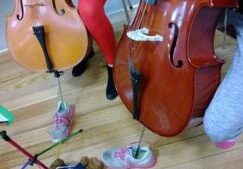
Southern Tasmanian Community Orchestra Etiquette

Before Rehearsal
- Enjoy each other’s company, ask questions of the conductor or your section leader, set up, and rehearse your part if you want to.
- If at all possible, try to get to rehearsal a few minutes ahead of the starting time, so you are seated ready to begin at the the allocated time.
- Before rehearsal, it is perfectly acceptable to practise your part, scales, arpeggios, or whatever you need to play to feel ready.
- A rehearsal is generally regarded to have begun when either the concertmaster stands to tune, or the conductor stands on the podium and asks for the orchestra’s attention. This is the time to stop rehearsing your part or chatting to other people.
Tuning
- Tuning begins when the concertmaster stands, turns to the First Violin section and plays an open string ‘A’
- Tune only when it it is your section’s turn to tune, and then only tune your ‘A’ string. Tuning will generally begin with the First Violin section, and will work around the the orchestra as each section has finished tuning. Play only when you are asked to play.
- Tune quietly, with long continuous bows.
- When you are satisfied with your ‘A’ string, sit quietly until all others in your section have tuned.
- Don’t practice while others are tuning.
- Respect others so that everyone can hear their instrument and the tuning note being given.
- It is important to check your ‘A’ string even if you have previously tuned to a tuning machine. The concertmaster’s ‘A’ in a string orchestra is the ultimate gauge.
- Do not begin tuning the remainder of your instrument until the concertmaster is seated, again quietly, so others can also hear their instruments.
Marking Your Music
- Have a pencil and rubber to write down bowings and instructions.
- Write any additional bowings/fingerings onto the music as they are given to you by your conductor or section leader.
- When marking any additional bowing, the second desk needs to put in any markings made by the leader, and then the third desk copies the 2nd desk etc…
- If your part isn’t the one on the music stand, it is important to also mark that, as you cannot rely on your memory for home practise. By marking both desk parts, it also allows others to accurately rehearse from your copy, should a desk be without a copy of the music at any particular rehearsal.
- When marking fingering, if it differs between desk partners, it is usual for the player on the outside of desk to mark above the notes, and the player on the inside below the notes.
Page Turning
- The person on the inside of the stand usually turns the pages of the music. In a standard orchestra setting, this is the player on the LEFT in the First Violin and Second Violin sections, and the player on the RIGHT in the Cello and Viola sections.
Division of Parts (‘Divisi’)
- Generally, the person on the outside plays the top part of the divisi parts. The person on the inside plays the bottom. This can be varied by agreement with your section leader, especially if difficulty is posing a problem. Never be ashamed to ask…we are a community orchestra, working together.
Section Leaders
- Each section of the orchestra has a leader, and their role is to liaise with the conductor and other section leaders, provide support to their section, and provide musical leadership during rehearsals and performances.
- Watch the section leader for bowings, length of notes, style of bowing, entrances, etc.
- If you have any questions regarding bowing, style, entrances etc, and there is not a quiet moment when the conductor is not rehearsing or speaking, jot your queries down and ask your section leader in the break or after rehearsal.
Talking and Rehearsing
- A general rule of thumb is “if the conductor is talking to the orchestra as a whole or another section, this is not the time for you to talk or rehearse your part.” It can become very difficult to hear the conductor if people are chatting or practising their part, and very distracting for the conductor.
- This rule of thumb also applies if a section leader or individual is asking a question of the conductor, even if the question doesn’t apply to you.
- When the conductor is working with another section, it is important to sit quietly and listen. There is much to be gained by listening, as it may apply to the general style of the piece, or be relevant for your part at another time.
- If you need to rehearse a section, bowing or fingering that has just been given, it is perfectly acceptable to ask the conductor for a moment to do so. Do not rehearse it “quietly” while others are being helped by the conductor, or other sections are playing. It is very distracting, and the sound will travel further than you think! Alternatively, practise the fingering silently, without bowing or plucking.
General
- Bring your own music and a music stand to every rehearsal.
- Whether you are playing or not, listen to those playing around you – not just to your own part but to every section, as your part fits with and around other sections.
- Follow the dynamics carefully, and blend with your section. Never be the player who plays louder than the rest of your section, unless you are specifically asked to do so. It becomes very distracting for the listener.
- Don’t be afraid to make mistakes or ask questions.
- Do not handle other people’s instruments unless they ask you.
- Do not tap your foot in time to the music.
- Observe dynamics, especially extreme soft dynamics such as pp, otherwise you won’t blend with your section and destroy the effect for the whole section.
Evening Break
- During COVID restrictions the mid rehearsal break is shortened to 5 minutes for a stretch and a toilet break.
- Outside of COVID restrictions we will take a break mid rehearsal for a cuppa and a snack. Please feel free to bring along a sample of your favourite baking if you wish to share.
- A donation box will be on hand to help cover the cost of catering, coffee, tea, sugar etc. (usually 50c).
- Please ensure your cup and any other utensils yo may have used are cleaned, dried and returned to the basket when finished.
Last but not least, smile and have fun!
